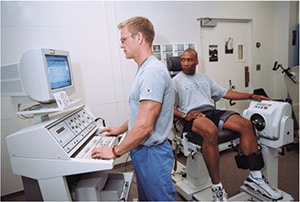When John Klimkiewicz, MD, signed on as an orthopaedic surgeon specializing in sport injuries at Georgetown University Hospital three years ago, he essentially became the team physician for the 670 athletes that make up all of the university’s varsity teams. In addition, he has a full practice of patients, which includes seeing as many as 140 patients a week and performing about 400 surgical cases a year.
This is all part of being on the team at one of the top sports medicine programs in the Washington, DC metropolitan area. The majority of patients seen by Dr. Klimkiewicz and the hospital’s outpatient physical therapists are between 20 and 50 years old. And these athletes are “looking to get back to 100% as quickly as possible,” Dr. Klimkiewicz said. “They are young, aggressive, Type-A people. They’re not going to accept take two Advil, and take two months off.”
Dr. Klimkiewicz and the physical therapists see university athletes from the school’s basketball, football, crew, lacrosse, track, field hockey and soccer teams. In addition, a number of amateur athletes seek them out. It’s very seasonal. For instance, before and after the Marine Corp Marathon, many of the runners come in with injuries, said Tracy Cartwright, outpatient clinical leader for Outpatient Physical Therapy.
Most of the surgery Dr. Klimkiewicz performs is done through “the scope,” he said. “I am fairly aggressive as far as treatment. Arthroscopy is much less invasive surgery.” Fifteen years ago, most of the same procedures were done using open surgery, he said, noting that today about 90% are done through the scope.
However, whenever possible, the sports medicine team tries to treat patients conservatively first. Much of the process is diagnosis and physical therapy, he said.
The Outpatient Physical Therapy Department recently purchased a Biodex Isokinetic machine, which is used for both testing and training patients, Cartwright said, adding that the machine is able to determine a baseline of strength versus bodyweight as well as normal standards for comparing left and right appendages.
The state-of-the-art machine is very useful in helping the therapists determine when patients are ready to go back to their former activities, Cartwright said, noting that treating sports injuries “make up more than half of the patients we treat.”
“We have a relationship with the athletic trainers at Georgetown University,” she continued. “We’ve tried to develop that relationship to make sure the athletes are not going back too soon. We strive to provide the best continuum of care possible.”
Athletes are a lot more motivated to return to their sport as soon as possible, Cartwright said. “Our goal is to develop a rehabilitation program that is injury and sport specific.”
When surgery is required, Dr. Klimkiewicz said the majority of patients do very well because “we’re dealing with relatively normal anatomy, and fairly elective procedures.” The patients are well educated and eager to get better quickly, he added.
“This is different from a lot of the subspecialties of orthopaedics,” Dr. Klimkiewicz said. “We’re trying to defy what Mother Nature brings us. I am very willing to work with the patients and find ways to keep them going.”